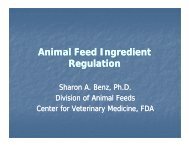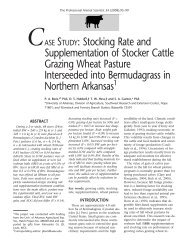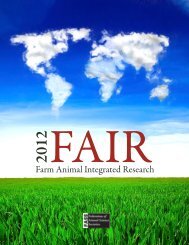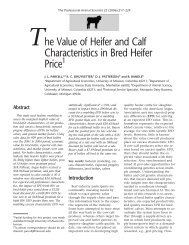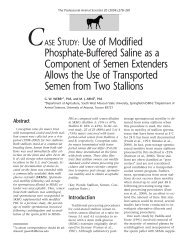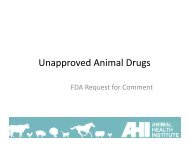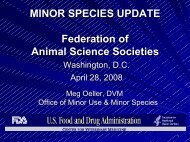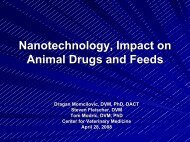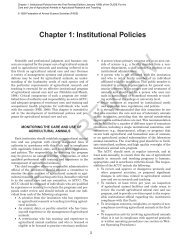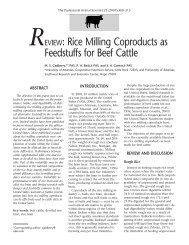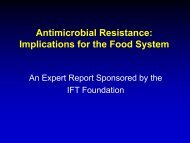Feed Ingredient (Additive) - Federation of Animal Science Societies
Feed Ingredient (Additive) - Federation of Animal Science Societies
Feed Ingredient (Additive) - Federation of Animal Science Societies
Create successful ePaper yourself
Turn your PDF publications into a flip-book with our unique Google optimized e-Paper software.
<strong>Feed</strong> <strong>Additive</strong>s and<strong>Ingredient</strong>sAmey AdamsDivision <strong>of</strong> <strong>Animal</strong> <strong>Feed</strong>sCenter for Veterinary MedicinePresented at the April 28, 2008 FASS Meeting, Washington, DC
What’s new?• Food <strong>Additive</strong> Petitions– One complete– Three filed• <strong>Ingredient</strong> definitions– Four accepted– Three in process• Novel substances
Selenium Yeast Petition• Regulation published in FederalRegister– Allows selenium yeast in beef cattle limit-fed and free-choice mineral supplements• Use in horse supplements was throughthe AAFCO definition process
Other FAP Filings• Eubacterium– detoxification <strong>of</strong> trichothecene mycotoxins• Ammoniated Formic Acid– Amendment to use as a pH control agentin drinking water for swine• Conjugated linoleic acid (CLA)– Source <strong>of</strong> fatty acids for swine diets
<strong>Ingredient</strong> Definitions• Two animal products• One fermentation product• Two yeast products• One vitamin i definitioniti• One sequestrant product
Air Dried <strong>Animal</strong> Blood Cells(Air Swept Tubular Drying):• Is the product obtained by drying red and whiteblood cells which have been separated from theplasma <strong>of</strong> clean, fresh, whole animal blood withonly such amounts <strong>of</strong> plasma as might occurunavoidably in good processing methods. The bloodcells are dried by exposing the cells to a heated airstream and retaining them in the dryer until theyhave reached the specified moisture content. Theguaranteed analysis is: maximum moisture <strong>of</strong> 11%;and a minimum protein <strong>of</strong> 90%. If the productbears a name descriptive <strong>of</strong> its kind, origin, orcomposition it must correspond thereto.
Imported jackrabbit bones• Use allowed if meets current AAFCOdefinitions
Dried FermentationBiomass:• is a nonviable biomass product resultingfrom the production <strong>of</strong> the amino acids bythe fermentation <strong>of</strong> nonpathogenic,nontoxigenic, risk group 1 Escherichia coli.The product must contain a minimum <strong>of</strong>75% crude protein on a dry matter basis.The product is intended as a source <strong>of</strong>protein. Non-protein nitrogen content (whenpresent) must be guaranteed.
SodiumHexametaphosphate• GRAS as a sequestrant subject to GMFP’s• Table 87.5 in Section 87, Special PurposeProducts– Sodium Hexametaphosphate– 21 CFR 582.6760– Sequestrant– In accordance with good manufacturing orfeeding practice as a tartar control agent coatedon dry food products for reducing theaccumulation <strong>of</strong> dental tartar in dogs or cats.
<strong>Ingredient</strong> Definitions inprocess:• Two yeast products– Proposed 2 definitions• _______ yeast culture and• _______ yeast– Industry concern regarding changes– Investigator attempting to address• One vitamin definition– Vitamin i E with silicon dioxide id as a carrier– Proposed definition was rejected by IDC– CVM and AAFCO working on potential solution
Novel Substances• Contract with National Academy <strong>of</strong><strong>Science</strong>s– Evaluation <strong>of</strong> 3 novel substances• Evening primrose oil• Lutein• Garlic– Develop framework to assess safety <strong>of</strong> novelsubstances– Completion date – this fall
Humate/ humic shalesubstances• Are safety concerns– Need approval <strong>of</strong> Food <strong>Additive</strong> Petitionfor use in feed–Many ypproducts on the market• CVM evaluating its options• One issue - lack <strong>of</strong> analytical method
Camelina meal• Byproduct from biodiesel production– Safety concerns• Novel class <strong>of</strong> glucosinolates• Other potentially toxic substances• Presents animal and human food concerns– Firm working to address issues
Chromium Substances• Safety Concern Raised– Published scientific literature• Cellular damage, genotoxicity– Firms addressed issue• Chromium methionine complex– CVM withdrew use <strong>of</strong> regulatory discretion– AAFCO definition moved to Withdrawn section <strong>of</strong>OP
Chromium Substances (cont)• Acceptable sources <strong>of</strong> chromium– Chromium propionate (def. 57.160)– Chromium tripicolinate (def. 57.155)• Use in swine diets only• Limited to 200 ppb• Chromium yeast is not acceptable– Same safety concerns as for otherorganic sources
Questions?




